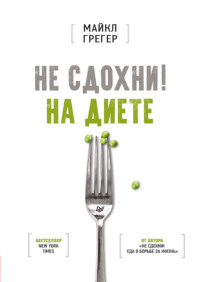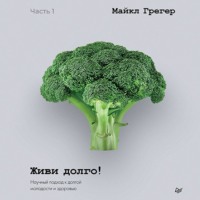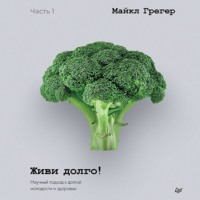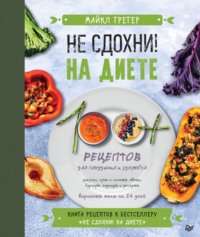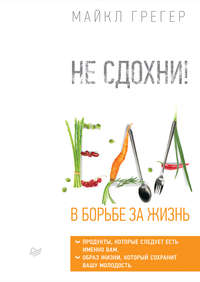
Полная версия
Живи долго! Научный подход к долгой молодости и здоровью
194
Daryabeygi-Khotbehsara R, Golzarand M, Ghaffari MP, Djafarian K. Nigella sativa improves glucose homeostasis and serum lipids in type 2 diabetes: a systematic review and meta-analysis. Complement Ther Med. 2017;35:6–13. https://pubmed.ncbi.nlm.nih.gov/29154069/
195
Agricultural Research Service, United States Department of Agriculture. Sweet sunnah, whole black seeds nigella sativa. FoodData Central. https://fdc.nal.usda.gov/fdc-app.html#/food-details/468991/nutrients. Published April 1, 2019. Accessed May 8, 2021.; https://fdc.nal.usda.gov/fdc-app.html#/food-details/468991/nutrients
196
Montazeri RS, Fatahi S, Sohouli MH, et al. The effect of nigella sativa on biomarkers of inflammation and oxidative stress: a systematic review and meta-analysis of randomized controlled trials. J Food Biochem. 2021;45(4):e13625. https://pubmed.ncbi.nlm.nih.gov/33559935/
197
He T, Xu X. The influence of Nigella sativa for asthma control: a meta-analysis. Am J Emerg Med. 2020;38(3):589–93. https://pubmed.ncbi.nlm.nih.gov/31892440/
198
Khabbazi A, Javadivala Z, Seyedsadjadi N, Malek Mahdavi A. A systematic review of the potential effects of Nigella sativa on rheumatoid arthritis. Planta Med. 2020;86(7):457–69. https://pubmed.ncbi.nlm.nih.gov/32274788/
199
Tajmiri S, Abbasalizad Farhangi M, Dehghan P. Nigella Sativa treatment and serum concentrations of thyroid hormones, transforming growth factor ß (TGF-ß) and interleukin 23 (IL-23) in patients with Hashimoto’s thyroiditis. Eur J Integr Med. 2016;8(4):576–80. https://www.sciencedirect.com/science/article/abs/pii/S1876382016300208
200
Ardakani Movaghati MR, Yousefi M, Saghebi SA, Sadeghi Vazin M, Iraji A, Mosavat SH. Efficacy of black seed (Nigella sativa L.) on kidney stone dissolution: a randomized, double-blind, placebo-controlled, clinical trial. Phytother Res. 2019;33(5):1404–12. https://pubmed.ncbi.nlm.nih.gov/30873671/
201
Latiff LA, Parhizkar S, Dollah MA, Hassan ST. Alternative supplement for enhancement of reproductive health and metabolic profile among perimenopausal women: a novel role of Nigella sativa. Iran J Basic Med Sci. 2014;17(12):980–5. https://pubmed.ncbi.nlm.nih.gov/25859301/
202
Lingesh A, Paul D, Naidu V, Satheeshkumar N. AMPK activating and anti adipogenic potential of Hibiscus rosa sinensis flower in 3T3-L1 cells. J Ethnopharmacol. 2019;233:123–30. https://pubmed.ncbi.nlm.nih.gov/30593890/
203
Amos A, Khiatah B. Mechanisms of action of nutritionally rich Hibiscus sabdariffa’s therapeutic uses in major common chronic diseases: a literature review [published online ahead of print, 2021 Jan 28]. J Am Coll Nutr. 2021;1–8. https://pubmed.ncbi.nlm.nih.gov/33507846/
204
Soleimani AR, Akbari H, Soleimani S, Beladi Mousavi SS, Tamadon MR. Effect of sour tea (Lipicom) pill versus captopril on the treatment of hypertension. J Renal Inj Prev. 2015;4(3):73–9. https://pubmed.ncbi.nlm.nih.gov/26468478/
205
Nwachukwu DC, Aneke EI, Nwachukwu NZ, Azubike N, Obika LF. Does consumption of an aqueous extract of Hibscus sabdariffa affect renal function in subjects with mild to moderate hypertension? J Physiol Sci. 2017;67(1):227–34. https://pubmed.ncbi.nlm.nih.gov/27221151/
206
Hopkins AL, Lamm MG, Funk JL, Ritenbaugh C. Hibiscus sabdariffa L. in the treatment of hypertension and hyperlipidemia: a comprehensive review of animal and human studies. Fitoterapia. 2013;85:84–94. https://pubmed.ncbi.nlm.nih.gov/23333908/
207
Bule M, Albelbeisi AH, Nikfar S, Amini M, Abdollahi M. The antidiabetic and antilipidemic effects of Hibiscus sabdariffa: a systematic review and meta-analysis of randomized clinical trials. Food Res Int (Ottawa). 2020;130:108980. https://pubmed.ncbi.nlm.nih.gov/32156406/
208
Abubakar SM, Ukeyima MT, Spencer JPE, Lovegrove JA. Acute effects of Hibiscus sabdariffa calyces on postprandial blood pressure, vascular function, blood lipids, biomarkers of insulin resistance and inflammation in humans. Nutrients. 2019;11(2):341. https://pubmed.ncbi.nlm.nih.gov/30764582/
209
Chang HC, Peng CH, Yeh DM, Kao ES, Wang CJ. Hibiscus sabdariffa extract inhibits obesity and fat accumulation, and improves liver steatosis in humans. Food Funct. 2014;5(4):734–9. https://pubmed.ncbi.nlm.nih.gov/24549255/
210
Wu CH, Huang CC, Hung CH, Yao FY, Wang CJ, Chang YC. Delphinidin-rich extracts of Hibiscus sabdariffa L. trigger mitochondria-derived autophagy and necrosis through reactive oxygen species in human breast cancer cells. J Funct Foods. 2016;25:279–90. https://www.sciencedirect.com/science/article/abs/pii/S175646461630144X?via%3Dihub
211
Salim LZA, Mohan S, Othman R, et al. Thymoquinone induces mitochondria-mediated apoptosis in acute lymphoblastic leukaemia in vitro. Molecules. 2013;18(9):11219–40. https://pubmed.ncbi.nlm.nih.gov/24036512/
212
Chen H, Chen T, Giudici P, Chen F. Vinegar functions on health: constituents, sources, and formation mechanisms. Compr Rev Food Sci Food Saf. 2016;15(6):1124–38. https://pubmed.ncbi.nlm.nih.gov/33401833/
213
Ali Z, Wang Z, Amir RM, et al. Potential uses of vinegar as a medicine and related in vivo mechanisms. Int J Vitam Nutr Res. 2018;86(3–4):1–12. https://pubmed.ncbi.nlm.nih.gov/29580192/
214
Bagnardi V, Rota M, Botteri E, et al. Alcohol consumption and site-specific cancer risk: a comprehensive dose-response meta-analysis. Br J Cancer. 2015;112(3):580–93. https://pubmed.ncbi.nlm.nih.gov/25422909/
215
Shield KD, Soerjomataram I, Rehm J. Alcohol use and breast cancer: a critical review. Alcohol Clin Exp Res. 2016;40(6):1166–81. https://pubmed.ncbi.nlm.nih.gov/27130687/
216
Ceddia RB. The role of AMP-activated protein kinase in regulating white adipose tissue metabolism. Mol Cell Endocrinol. 2013;366(2):194–203. https://pubmed.ncbi.nlm.nih.gov/22750051/
217
Center for Food Safety and Applied Nutrition, Office of Regulatory Affairs. CPG sec. 525.825 vinegar, definitions – adulteration with vinegar eels. United States Food and Drug Administration. https://www.fda.gov/regulatory-information/search-fda-guidance-documents/cpg-sec-525825-vinegar-definitions-adulteration-vinegar-eels. Published March 1995. Accessed May 8, 2021.; https://www.fda.gov/regulatory-information/search-fda-guidance-documents/cpg-sec-525825-vinegar-definitions-adulteration-vinegar-eels
218
Park J, Kim J, Kim J, et al. Pomegranate vinegar beverage reduces visceral fat accumulation in association with AMPK activation in overweight women: a double-blind, randomized, and placebo-controlled trial. J Funct Foods. 2014;8:274–81. https://www.sciencedirect.com/science/article/abs/pii/S1756464614001273
219
Kondo T, Kishi M, Fushimi T, Ugajin S, Kaga T. Vinegar intake reduces body weight, body fat mass, and serum triglyceride levels in obese Japanese subjects. Biosci Biotechnol Biochem. 2009;73(8):1837–43. https://pubmed.ncbi.nlm.nih.gov/19661687/
220
Johnston C, Quagliano S, White S. Vinegar ingestion at mealtime reduced fasting blood glucose concentrations in healthy adults at risk for type 2 diabetes. J Funct Foods. 2013;5(4):2007–11. https://www.sciencedirect.com/science/article/abs/pii/S1756464613001874
221
Mitrou P, Petsiou E, Papakonstantinou E, et al. Vinegar consumption increases insulin-stimulated glucose uptake by the forearm muscle in humans with type 2 diabetes. J Diabetes Res. 2015;2015:175204. https://pubmed.ncbi.nlm.nih.gov/26064976/
222
Hu GX, Chen GR, Xu H, Ge RS, Lin J. Activation of the AMP activated protein kinase by short-chain fatty acids is the main mechanism underlying the beneficial effect of a high fiber diet on the metabolic syndrome. Med Hypotheses. 2010;74(1):123–6. https://pubmed.ncbi.nlm.nih.gov/19665312/
223
Abid M, Memon Z, Shaheen S, Ahmed F, Shaikh MZ, Agha F. Comparison of apple cider vinegar and metformin combination with metformin alone in newly diagnosed type 2 diabetic patients: a randomized controlled trial. Int J Med Res Health Sci. 2020;9(2):1–7. https://www.ijmrhs.com/abstract/comparison-of-apple-cider-vinegar-and-metformin-combination-with-metformin-alone-in-newly-diagnosed-type-2-diabetic-pati-44684.html
224
Sakakibara S, Murakami R, Takahashi M, et al. Vinegar intake enhances flow-mediated vasodilatation via upregulation of endothelial nitric oxide synthase activity. Biosci Biotechnol Biochem. 2010;74(5):1055–61. https://pubmed.ncbi.nlm.nih.gov/20460711/
225
Beheshti Z, Chan YH, Nia HS, et al. Influence of apple cider vinegar on blood lipids. Life Sci J. 2012;9(4):2431–40. https://www.lifesciencesite.com/lsj/life0904/360_10755life0904_2431_2440.pdf
226
Chuang MH, Chiou SH, Huang CH, Yang WB, Wong CH. The lifespan-promoting effect of acetic acid and Reishi polysaccharide. Bioorg Med Chem. 2009;17(22):7831–40. https://pubmed.ncbi.nlm.nih.gov/19837596/
227
Hu FB, Stampfer MJ, Manson JE, et al. Dietary intake of alpha-linolenic acid and risk of fatal ischemic heart disease among women. Am J Clin Nutr. 1999;69(5):890–7. https://pubmed.ncbi.nlm.nih.gov/10232627/
228
Hu GX, Chen GR, Xu H, Ge RS, Lin J. Activation of the AMP activated protein kinase by short-chain fatty acids is the main mechanism underlying the beneficial effect of a high fiber diet on the metabolic syndrome. Med Hypotheses. 2010;74(1):123–6. https://pubmed.ncbi.nlm.nih.gov/19665312/
229
Koç F, Mills S, Strain C, Ross RP, Stanton C. The public health rationale for increasing dietary fibre: health benefits with a focus on gut microbiota. Nutr Bull. 2020;45:294–308. https://onlinelibrary.wiley.com/doi/10.1111/nbu.12448
230
Pritchard SE, Marciani L, Garsed KC, et al. Fasting and postprandial volumes of the undisturbed colon: normal values and changes in diarrhea-predominant irritable bowel syndrome measured using serial MRI. Neurogastroenterol Motil. 2014;26(1):124–30. https://pubmed.ncbi.nlm.nih.gov/24131490/
231
Tang R, Li L. Modulation of short-chain fatty acids as potential therapy method for type 2 diabetes mellitus. Can J Infect Dis Med Microbiol. 2021;2021:6632266. https://pubmed.ncbi.nlm.nih.gov/33488888/
232
Hu GX, Chen GR, Xu H, Ge RS, Lin J. Activation of the AMP activated protein kinase by short-chain fatty acids is the main mechanism underlying the beneficial effect of a high fiber diet on the metabolic syndrome. Med Hypotheses. 2010;74(1):123–6. https://pubmed.ncbi.nlm.nih.gov/19665312/
233
Spiller G, ed. Topics in Dietary Fiber Research. Plenum Press; 1978. https://link.springer.com/book/10.1007/978-1-4684-2481-2
234
Eaton SB, Eaton SB, Konner MJ. Paleolithic nutrition revisited: a twelve-year retrospective on its nature and implications. Eur J Clin Nutr. 1997;51(4):207–16. https://pubmed.ncbi.nlm.nih.gov/9104571/
235
Usual nutrient intake from food and beverages, by gender and age: what we eat in America, NHANES 2015–2018. Agricultural Research Service, United States Department of Agriculture. https://www.ars.usda.gov/ARSUserFiles/80400530/pdf/usual/Usual_Intake_gender_WWEIA_2015_2018.pdf. Published January 2021. Accessed December 25, 2022.; https://www.ars.usda.gov/ARSUserFiles/80400530/pdf/usual/Usual_Intake_gender_WWEIA_2015_2018.pdf
236
McRorie JW. Evidence-based approach to fiber supplements and clinically meaningful health benefits, part 1: what to look for and how to recommend an effective fiber therapy. Nutr Today. 2015;50(2):82–9. https://pubmed.ncbi.nlm.nih.gov/25972618/
237
López M. Hypothalamic AMPK: a golden target against obesity? Eur J Endocrinol. 2017;176(5):R235–46. https://pubmed.ncbi.nlm.nih.gov/28232370/
238
Morgunova GV, Klebanov AA. Age-related AMP-activated protein kinase alterations: from cellular energetics to longevity. Cell Biochem Funct. 2019;37(3):169–76. https://pubmed.ncbi.nlm.nih.gov/30895648/
239
Американская единица объема «чашка» (cup) равна 240 мл. – Примеч. ред.
240
There are many different types of autophagy, including chaperone-mediated autophagy and microautophagy. In this book, I’m referring to macroautophagy.
241
Tschachler E, Eckhart L. Autophagy: how to control your intracellular diet. Br J Dermatol. 2017;176(6):1417–9. https://pubmed.ncbi.nlm.nih.gov/28581245/
242
Levine B, Klionsky DJ. Autophagy wins the 2016 Nobel Prize in Physiology or Medicine: breakthroughs in baker’s yeast fuel advances in biomedical research. PNAS. 2017;114(2):201–5. https://pubmed.ncbi.nlm.nih.gov/28039434/
243
Vijayakumar K, Cho G. Autophagy: an evolutionarily conserved process in the maintenance of stem cells and aging. Cell Biochem Funct. 2019;37(6):452–8. https://pubmed.ncbi.nlm.nih.gov/31318072/
244
Kouda K, Iki M. Beneficial effects of mild stress (hormetic effects): dietary restriction and health. J Physiol Anthropol. 2010;29(4):127–32. https://pubmed.ncbi.nlm.nih.gov/20686325/
245
Tschachler E, Eckhart L. Autophagy: how to control your intracellular diet. Br J Dermatol. 2017;176(6):1417–9. https://pubmed.ncbi.nlm.nih.gov/28581245/
246
Cuervo AM. Calorie restriction and aging: the ultimate “cleansing diet.” J Gerontol A Biol Sci Med Sci. 2008;63(6):547–9. https://academic.oup.com/biomedgerontology/article/63/6/547/573952
247
Madeo F, Zimmermann A, Maiuri MC, Kroemer G. Essential role for autophagy in life span extension. J Clin Invest. 2015;125(1):85–93. https://pubmed.ncbi.nlm.nih.gov/25654554/
248
Pyo JO, Yoo SM, Ahn HH, et al. Overexpression of Atg5 in mice activates autophagy and extends lifespan. Nat Commun. 2013;4:2300. https://pubmed.ncbi.nlm.nih.gov/23939249/
249
Wong SQ, Kumar AV, Mills J, Lapierre LR. Autophagy in aging and longevity. Hum Genet. 2020;139(3):277–90. https://pubmed.ncbi.nlm.nih.gov/31144030/
250
Cuervo AM. Calorie restriction and aging: the ultimate “cleansing diet.” J Gerontol A Biol Sci Med Sci. 2008;63(6):547–9. https://academic.oup.com/biomedgerontology/article/63/6/547/573952
251
Meijer AJ. Autophagy in practice: stevia and leucine. Autophagy. 2019;15(12):2043. https://pubmed.ncbi.nlm.nih.gov/31455125/
252
Meijer AJ, Lorin S, Blommaart EF, Codogno P. Regulation of autophagy by amino acids and MTOR-dependent signal transduction. Amino Acids. 2015;47(10):2037–63. https://pubmed.ncbi.nlm.nih.gov/24880909/
253
Показатель физической работоспособности, определяет максимальное количество кислорода, которое может потреблять организм во время интенсивных упражнений. – Примеч. ред.
254
Escobar KA, Cole NH, Mermier CM, VanDusseldorp TA. Autophagy and aging: maintaining the proteome through exercise and caloric restriction. Aging Cell. 2019;18(1):e12876. https://pubmed.ncbi.nlm.nih.gov/30430746/
255
Brandt N, Gunnarsson TP, Bangsbo J, Pilegaard H. Exercise and exercise training – induced increase in autophagy markers in human skeletal muscle. Physiol Rep. 2018;6(7):e13651. https://pubmed.ncbi.nlm.nih.gov/29626392/
256
Escobar KA, Cole NH, Mermier CM, VanDusseldorp TA. Autophagy and aging: maintaining the proteome through exercise and caloric restriction. Aging Cell. 2019;18(1):e12876. https://pubmed.ncbi.nlm.nih.gov/30430746/
257
Cuervo AM. Calorie restriction and aging: the ultimate “cleansing diet.” J Gerontol A Biol Sci Med Sci. 2008;63(6):547–9. https://academic.oup.com/biomedgerontology/article/63/6/547/573952
258
Melnik BC. Leucine signaling in the pathogenesis of type 2 diabetes and obesity. World J Diabetes. 2012;3(3):38. https://pubmed.ncbi.nlm.nih.gov/22442749/
259
Rittig N, Bach E, Thomsen HH, et al. Anabolic effects of leucine-rich whey protein, carbohydrate, and soy protein with and without ß-hydroxy-ß-methylbutyrate (Hmb) during fasting-induced catabolism: a human randomized crossover trial. Clin Nutr. 2017;36(3):697–705. https://pubmed.ncbi.nlm.nih.gov/27265181/
260
Tareke E, Rydberg P, Karlsson P, Eriksson S, Törnqvist M. Analysis of acrylamide, a carcinogen formed in heated foodstuffs. J Agric Food Chem. 2002;50:4998–5006. https://pubmed.ncbi.nlm.nih.gov/12166997/
261
Song D, Xu C, Holck AL, Liu R. Acrylamide inhibits autophagy, induces apoptosis and alters cellular metabolic profiles. Ecotoxicol Environ Saf. 2021;208:111543. https://pubmed.ncbi.nlm.nih.gov/33396091/
262
Huang M, Jiao J, Wang J, Chen X, Zhang Y. Associations of hemoglobin biomarker levels of acrylamide and all-cause and cardiovascular disease mortality among U.S. adults: National Health and Nutrition Examination Survey 2003–2006. Environ Pollut. 2018;238:852–8. https://pubmed.ncbi.nlm.nih.gov/29627755/
263
Naruszewicz M, Zapolska-Downar D, Kosmider A, et al. Chronic intake of potato chips in humans increases the production of reactive oxygen radicals by leukocytes and increases plasma C-reactive protein: a pilot study. Am J Clin Nutr. 2009;89(3):773–7. https://pubmed.ncbi.nlm.nih.gov/19158207/
264
Chase P, Mitchell K, Morley JE. In the steps of giants: the early geriatrics texts. J Am Geriatr Soc. 2000;48(1):89–94. https://pubmed.ncbi.nlm.nih.gov/10642028/
265
Madeo F, Zimmermann A, Maiuri MC, Kroemer G. Essential role for autophagy in life span extension. J Clin Invest. 2015;125(1):85–93. https://pubmed.ncbi.nlm.nih.gov/25654554/
266
Arnesen E, Huseby NE, Brenn T, Try K. The Tromsø Heart Study: distribution of, and determinants for, gamma-glutamyltransferase in a free-living population. Scand J Clin Lab Invest. 1986;46(1):63–70. https://pubmed.ncbi.nlm.nih.gov/2869572/
267
Ruhl CE, Everhart JE. Coffee and tea consumption are associated with a lower incidence of chronic liver disease in the United States. Gastroenterology. 2005;129(6):1928–36. https://pubmed.ncbi.nlm.nih.gov/16344061/
268
Hayat U, Siddiqui AA, Okut H, Afroz S, Tasleem S, Haris A. The effect of coffee consumption on the non-alcoholic fatty liver disease and liver fibrosis: a meta-analysis of 11 epidemiological studies. Ann Hepatol. 2021;20:100254. https://pubmed.ncbi.nlm.nih.gov/32920163/
269
Ray K. Caffeine is a potent stimulator of autophagy to reduce hepatic lipid content – a coffee for NAFLD? Nat Rev Gastroenterol Hepatol 2013;10:563. https://pubmed.ncbi.nlm.nih.gov/23982685/
270
Sinha RA, Farah BL, Singh BK, et al. Caffeine stimulates hepatic lipid metabolism by the autophagy-lysosomal pathway in mice. Hepatology. 2014;59(4):1366–80. https://pubmed.ncbi.nlm.nih.gov/23929677/
271
Czachor J, Milek M, Galiniak S, Stepien K, Dzugan M, Molon M. Coffee extends yeast chronological lifespan through antioxidant properties. Int J Mol Sci. 2020;21(24):9510. https://pubmed.ncbi.nlm.nih.gov/33327536/
272
Sutphin GL, Bishop E, Yanos ME, Moller RM, Kaeberlein M. Caffeine extends life span, improves healthspan, and delays age-associated pathology in Caenorhabditis elegans. Longev Healthspan. 2012;1(1):9. https://pubmed.ncbi.nlm.nih.gov/24764514/
273
Pietrocola F, Malik SA, Mariño G, et al. Coffee induces autophagy in vivo. Cell Cycle. 2014;13(12):1987–94. https://pubmed.ncbi.nlm.nih.gov/24769862/
274
Takahashi K, Yanai S, Shimokado K, Ishigami A. Coffee consumption in aged mice increases energy production and decreases hepatic mTOR levels. Nutrition. 2017;38:1–8. https://pubmed.ncbi.nlm.nih.gov/28526373/
275
Известный слоган кофейного бренда Maxwell House. – Примеч. ред.
276
Saab S, Mallam D, Cox GA, Tong MJ. Impact of coffee on liver diseases: a systematic review. Liver Int. 2014;34(4):495–504. https://pubmed.ncbi.nlm.nih.gov/24102757/
277
Kanbay M, Siriopol D, Copur S, et al. Effect of coffee consumption on renal outcome: a systematic review and meta-analysis of clinical studies. J Ren Nutr. 2021;31(1):5–20. https://pubmed.ncbi.nlm.nih.gov/32958376/
278
Grosso G, Godos J, Galvano F, Giovannucci EL. Coffee, caffeine, and health outcomes: an umbrella review. Annu Rev Nutr. 2017;37:131–56. https://pubmed.ncbi.nlm.nih.gov/28826374/
279
Thomas DR, Hodges ID. Dietary research on coffee: improving adjustment for confounding. Curr Dev Nutr. 2020;4(nzz142). https://pubmed.ncbi.nlm.nih.gov/31938763/
280
Duregon E, Bernier M, de Cabo R. A glance back at the journal of gerontology – coffee, dietary interventions and life span. J Geront A Biol Sci Med Sci. 2020;75(11):2029–30. https://pubmed.ncbi.nlm.nih.gov/33057720/
281
Li Q, Liu Y, Sun X, et al. Caffeinated and decaffeinated coffee consumption and risk of all-cause mortality: a dose – response meta-analysis of cohort studies. J Hum Nut Diet. 2019;32(3):279–87. https://pubmed.ncbi.nlm.nih.gov/30786114/
282
Spiegelhalter D. Using speed of ageing and “microlives” to communicate the effects of lifetime habits and environment. BMJ. 2012 Dec 14;345:e8223. https://pubmed.ncbi.nlm.nih.gov/23247978/
283
Poole R, Kennedy OJ, Roderick P, Fallowfield JA, Hayes PC, Parkes J. Coffee consumption and health: umbrella review of meta-analyses of multiple health outcomes. BMJ. 2017;359:j5024. https://pubmed.ncbi.nlm.nih.gov/29167102/
284
Loftfield E, Cornelis MC, Caporaso N, Yu K, Sinha R, Freedman N. Association of coffee drinking with mortality by genetic variation in caffeine metabolism: findings from the UK Biobank. JAMA Intern Med. 2018;178(8):1086. https://pubmed.ncbi.nlm.nih.gov/29971434/
285
Poole R, Kennedy OJ, Roderick P, Fallowfield JA, Hayes PC, Parkes J. Coffee consumption and health: umbrella review of meta-analyses of multiple health outcomes. BMJ. 2017;359:j5024. https://pubmed.ncbi.nlm.nih.gov/29167102/
286
Gao LJ, Dai Y, Li XQ, Meng S, Zhong ZQ, Xu SJ. Chlorogenic acid enhances autophagy by upregulating lysosomal function to protect against SH-SY5Y cell injury induced by H2O2. Exp Ther Med. 2021;21(5):426. https://pubmed.ncbi.nlm.nih.gov/33747165/
287







